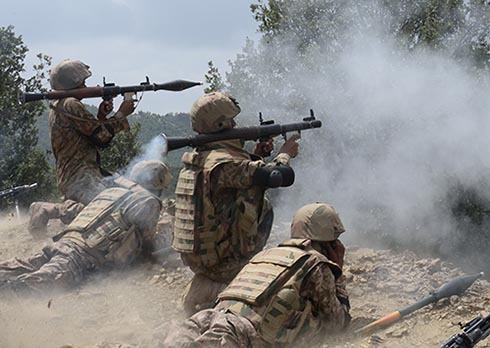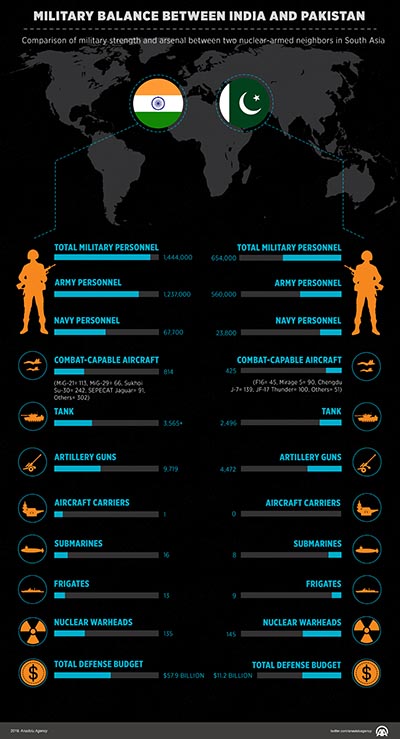Numbers and sizes are a constant factor while computing combat military potentials of various countries, but a host of other factors have also to be factored in — some having weightage even more than the mere mass of the forces, provided the ratio of numbers lie between a certain acceptable bracket . As Napoleon said, “In war, moral power is to the physical as three parts out of four.” But in this piece, the ‘moral power’ and the ‘faith’ factors will not be discussed to keep the comparison objective and non-controversial. The roots of the organisation, training and traditions of the Pakistani and the Indian Armed Forces emanate from the British era, though both the countries covered a lot of distance through indigenous reforms and introduced many new features. Yet, the British flavour is still dominant in spite of the fact that the Pakistani forces embraced more of American and European equipment and training, while India initially got influenced by the Russian equipment and military doctrines. Even after Pakistan purchased Chinese defence hardware and India opened up to military equipment from all over the world, the two forces in terms of their world view and military philosophies are more or less the same in their characteristics.

As far as the military spending is concerned, India allocates around seven to eight times more budget than Pakistan in dollar terms. Last year, India spent about $56 billion on defence compared to Pakistan’s $7.5 billion on the sustenance and modernisation of the armed forces. The Indian military expenditure is a little over 2% of its GDP, while Pakistan’s hovers at around 3%. As we witness an expansion in the Indian economy and contraction in Pakistan’s case, their armed forces are likely to develop and stagnate accordingly. Difficult times lie ahead for the Pakistan Armed Forces if immediate rethinking is not done about their organizational structure, the fighting strategy and administrative aspects, including the nuclear forces. The only redeeming factor is the time lag between the economic weakness and its effects on the war readiness and fighting ability of any force. But there is no time for procrastination and delaying the review of the total political, economic and security environment, and then an immediate adjustment to suit the modern character of wars and the evolving new doctrines. The armed forces cannot insist on maintaining the same organisational and recruitment outfits, training and administrative routines, while remaining oblivious to the hard economic conditions and international political environment. The changing character of modern warfare – that is hybrid in nature — also needs to be embraced, keeping in mind that it cannot be fought by kinetic forces alone. Both India and Pakistan need to respond to the modern warfare demands and whosoever exhibits agility to conform and adapt to the new and changed environment earlier will be better off. India to an extent has understood the importance of employing the non-state actors, economic and political instruments etc. against its enemies, whereas Pakistan, under international pressure, seems to have retracted in these areas, creating a big disadvantage for itself.
The Indian land forces are more than double that of Pakistan (1,200,000 vs 550,000), and their paramilitary forces are five times larger (2,500,000 vs 500,000). India also maintains a much larger reservist’s pool. The combat potential of the Indian Air Force is about two-and-a-half-times and that of the Indian Navy close to three-and- a-half-times than ours. In these comparisons, the ratio of high tech components have not been weighed in. But how much of this apparent fighting potential can actually get translated into real combat, is anybody’s guess. However, some recent events like the Pakistan Air Force’s ‘Swift Retort’, Pakistan Navy’s detection of Indian submarines and the ‘clashes and skirmishes at Galawan’ between the Indian and Chinese troops, clearly indicate the vulnerabilities of a large fighting force that is well equipped, but wanting in waging modern integrated operations. Pakistan, most probably enjoys advantage in the net centric integrated operations and likely to possess more drones, specifically the killer drones, mostly indigenously manufactured. So, in any limited conflict, Pakistan is not likely to face any major disadvantage, and in any large-scale aggression, India will be risking touching, hitherto unknown and ambiguous nuclear threshold of Pakistan. Only caveat being if some other powers decide to help India in terms of providing real-time information on the movements and locations of the Pakistani forces. This is likely due to agreements between the United States and India.

The nuclear forces of the two sides are nearly at parity. However, many assessments show that the Pakistani arsenal and delivery means are better organised and probably more in numbers. The Indian advantage of possessing ICBMs of longer ranges are irrelevant in the Pak-India context. Pakistan’s delivery means have sufficient ranges to cover the farthest Indian bases deep into the Indian Ocean. However, the Indian ABM System S-400, acquired from Russia, not only upsets the stability of mutual deterrence, but gives India an Iron-dome advantage in the nuclear race. However, these systems do not give a blanket cover to the entire length and breadth of the country and its socio-political and military assets. Also, Pakistan’s Ababeel MIRVs (multiple, independently targeting re-entry vehicles) and Babur cruise missiles can penetrate through best of the air defences. I will not delve deep into the two nuclear policies and thresholds etc as it falls outside the purview of this article. Suffice to say that Indian side keeps asking us to agree on ‘no first use’ and we in turn tell them to have a ‘no-aggression pact’. All said and done Pakistan’s nuclear capability is a great equaliser.
Even if we keep the two sides’ senior leadership at the same keel, Pakistan’s junior leadership and the ranks in the forces have displayed extraordinary skills and valour whenever put to test. This fact emerges from the analysis of minor operations where our junior officers led from the front, fought valiantly and in many cases embraced martyrdom in unprecedented ratios with respect to rank and file. The Pakistan Armed Forces are known for their stringent standards of training, especially training with troops and equipment in the field. Due to economic constraints, there may be a downward trend in this real environment training, but this has been amply compensated by actual fighting against terrorism. However, being an asymmetric conflict, it only hones a portion of force and not necessarily the entire military outfit.
Synergy in policies (foreign, economic, security, interior etc.) creates multiplying effect and strengthens the overall internal cohesion of any country. India is doing well in this area except for its attitude towards minorities that remains the Achilles heel. In our case, the policies need to be better coordinated, which at times are not well aligned, resulting in a weaker net-effect. Whereas this is true that diplomacy, economy and security should be dealt with by the specialists of their fields, nevertheless the main direction and focus must be provided by the apex political authority. In case of any inefficiency or procrastination the vacuum gets filled by non-specialist entities and that kills the entire system. Our institutions (legislature, executive, judiciary, Armed Forces, media etc.) must learn to operate within their own special and ordained domains. Non-adherence to this can create a huge negative impact on the professionalism and respect of various institutions, including the Armed Forces. And for a fighting force, the support of the people is the backbone of their morale.
Conclusion
The Pakistan Armed Forces (including the nuclear prowess) presently are in a reasonable position to deter any Indian aggressive designs, and can re-establish deterrence if it fails temporarily. But Pakistan suffers weakness in the lower spectrum of conflicts due to our unwarranted acquiescence to the international pressures and not fully comprehending the consequences of appeasing policies.
Recommendations
- Review the entire military system to make it smart, efficient, participatory, and responsive to latest means and doctrines of warfare.
- Make the system economical by leveraging the nuclear-capability in terms of policies and doctrines.
- Create an ‘Apex Hybrid Warfare Headquarters’ that plans, directs and supervises the hybrid operations. The head (NSA, CJCSC, or any appropriate appointee) of this entity should be directly responsible to the Prime Minister and must house all requisite expertise under one roof with relevant institutions and ministries mandated to execute the instructions.
- Decision making mechanisms of all the force headquarters be modified and honed to eradicate the vulnerability of pursuing one man’s thought process, ensuring formal consultative process mandatory and binding, rather than keeping it optional. All strategic decisions must remain within the directives and approvals of the apex political policy.
- The government, the Defence Ministry and the Armed Forces must consider and remove the gaps, if any, in our ‘Full Spectrum Deterrence’ and consider instituting the low intensity and hybrid warfare instruments and re-organise accordingly. The importance of exhibiting the political and military will in the deterrence theory must be fully grasped.
- Defence pacts and mutually beneficial security arrangements with friendly countries should be given importance and priority to balance out the unprecedented and ever increasing gap between the Pakistani and the Indian forces.
This essay only outlines the philosophy and contours of a proposed new military system after evaluating the comparison with the main external adversary and discerning the gaps that need to be bridged, remaining within the prevailing politico economic constraints. All information shared here is available in the open sources. We need to be agile and responsive, as there is no luxury available for procrastination and delays. Smart strategy dictates evolving intelligent plans to achieve the political objectives by integrating and making best use of available resources.



